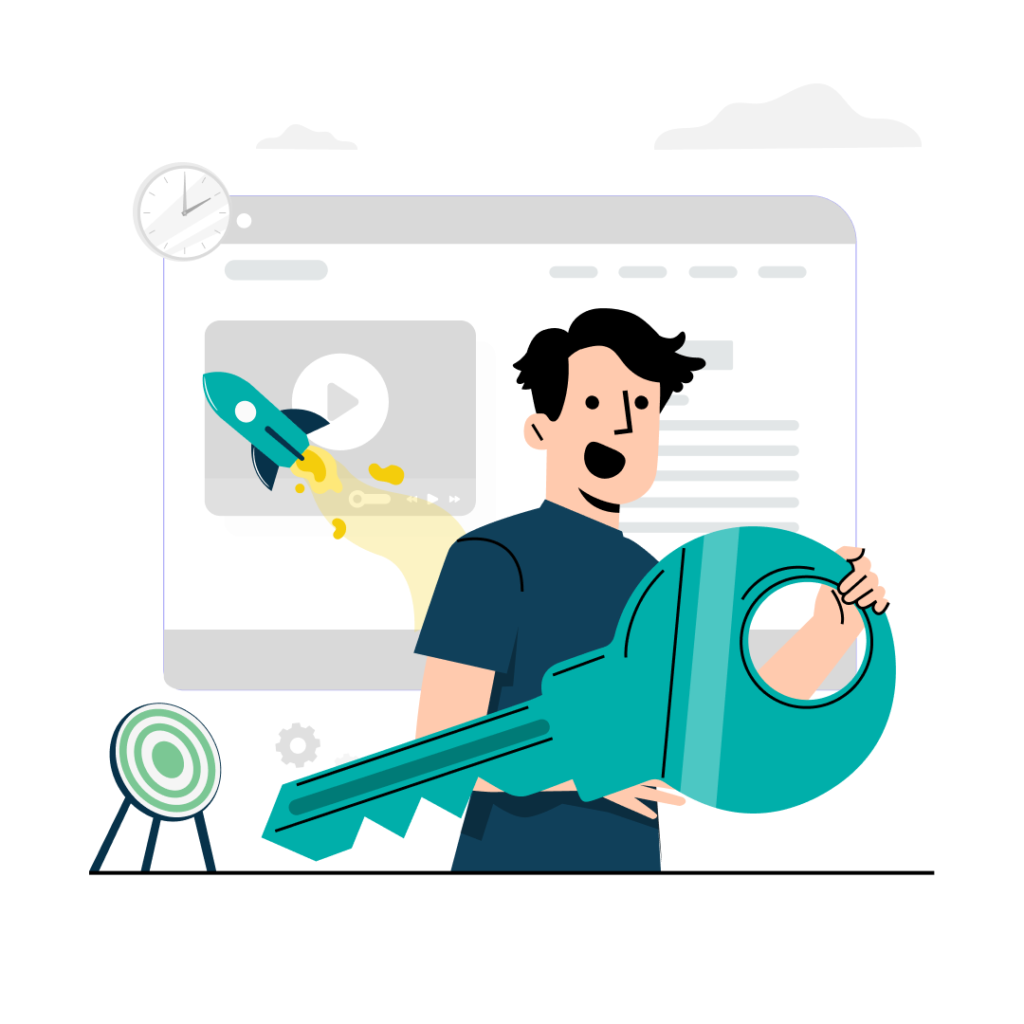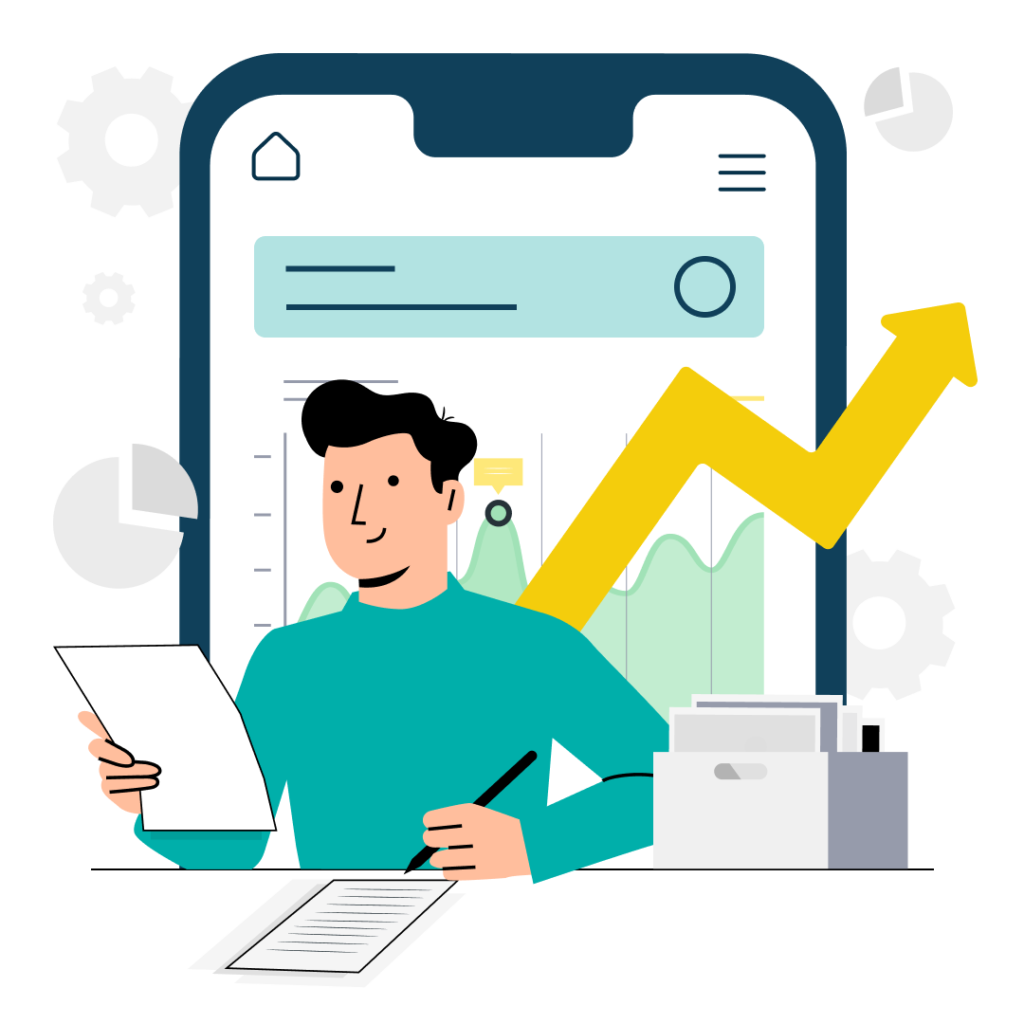This might be you. You know you need a website. Or you know you need an app. Or both. Whatever you choose, building these digital products is going to be a major investment and you need it to pay off.
At this stage, before you’ve committed resources, the most important thing to get right is the alignment between your business goals and your digital product development. Getting these aligned and keeping them aligned is the key to success and that success is driven by strategically maximising your ROI.
This alignment requires a deep and thorough analysis of your options and you might need to adopt new processes to get there. That’s why we’re going to give you a good overview of what you need to do. To illustrate the process we’ll be using a fictional B2B event management SaaS we’ve named “Conferensity”.

The first step in the process is determining the connections between your business goals and your potential digital products.
Uniting Business Goals and Digital Projects: A Recipe for Success
As we’ve said, the key to achieving successful outcomes with your digital products is ensuring they’re in sync with your overarching bsuiness objectives. These key objectives might be things like:
- increased reach
- increased sales
- competitive advantage through broader capabilities
- cost savings through new efficiencies
- cost savings through enhanced productivity
It’s up to you to decide which goals you should be chasing. Looking at that short list, they all seem worth pursuing. They are. But you need to prioritise your goals with an eye not just towards the possible ROI, but also the feasibility of execution by your team and solution partners.
To see how making these choices might work in practice, let’s look at Conferensity as an example of how to unite business goals and digital products.
Conferensity is currently a basic B2B event management platform. Their primary goal:
“To become a comprehensive conference solution and enjoy the increased market share and revenue possibilities this will create.”
Their strategy involves expanding their web-based software’s capabilities and developing two apps – one for conference admins and another for attendees.
While these are three digital products, 1 website and 2 apps, there is actually a fourth project – the updated backend that will implement the features the website and apps will provide interfaces for. This backend will also require extensive work to provide all the necessary admin features to manage the new frontend features.
By dedicating their resources to these four digital projects Conferensity is actively working towards achieving their primary business objective.
If Conferensity were in a different industry/market they might have different goals. Let’s look quickly at some other examples:
- E-commerce: An online retailer’s business goal might be to increase sales and improve customer retention. To achieve this they might decide to focus on developing an app with personalised shopping experiences, loyalty rewards, and seamless checkout processes.
- Healthcare: A telemedicine provider might have the goal of expanding its patient base while improving patient outcomes. It decides what it needs is an app that provides easy appointment scheduling, secure video calls with healthcare professionals, and access to medical records.
- Education: An edtech company wants to increase user engagement and course completion rates. Their goal is to update their learning website with better interactive lessons and add gamification elements and progress tracking to meet these business goals.
Returning to Conferensity, let’s go into a little more detail about their goals and plans. Here is some of what they want their products to do:
- manage venue communication and arrangements (such as contracts, venue layout, and extra services like conference Wi-Fi, local tours, etc), and
- handle communication with speakers, panel members, and guests (including contracts, accommodation, presentation reservations, and travel).
Their first app will be for conference admins, duplicating the client-accessible website’s functionality.
The second app, designed for attendees, will allow attendees to reserve seats, purchase tickets to the conference, and pay for any related services. It will also have features like schedules and venue maps, presentation start reminders, live questions via chat rooms, presentation feedback, and special features for speakers.
By selecting specific features for their user-facing digital products that will support their business goals, Conferensity is weaving together their business objectives and digital initiatives in a way that maximises the potential for success.
Pinpointing Key Objectives and Priorities: The Guardrails and Guidelines for Effective Development
You can’t afford to waste time or burn money developing your digital products. So you need to identify and prioritise your key objectives and the initiatives that are going to achieve them.
Your key objectives are often broad and can sound obvious – “increase revenues by 12% YOY”, “Reduce monthly churn by 5%”, but each objective will require hundreds if not thousands of actions and even more decisions and judgements across your team. Too many things to specify beforehand. So keeping them simple and clear avoids “analysis paralysis”, enables autonomy across teams, and keeps everyone moving in the same direction.
Having established your objectives you then examine your proposed digital products and determine exactly how they are going to help you achieve them.
For products like apps and websites this is a bit of a two-way process. You know you need the digital products. You just need to ensure you get the link between their features and your objectives right.
The outcome of this process is the first high-level breakdown of your product development plan.
These are the general steps you need to take to identify your objectives and then to rank them by priority:
- Assess the business landscape: Do some SWOT analysis. Analyse your current products, services, and customer segments to identify areas that could benefit from web and app solutions. Do some user interviews with your existing customers. Confirm that you understand their pain points and you can address them.
- Define your business goals: Make sure they’re clear, measurable and have sensible time constraints. Examples of the kind of goals you might consider: increasing revenue, growing your customer base, improving customer satisfaction, and expanding into new markets.
- Estimate your digital products’ potential impact: You want to break this down by product and break down each product into its planned features. Then for each item you need to consider things like their revenue potential, any competitive advantage they’ll bring, as well as the perceived value they will generate for your users. You’ll also need to estimate the resources required for implementation of each item.
- Prioritise based on ROI: Taking the information from step 3, order your options by expected ROI. It won’t be a straightforward “Sort Descending” on your ROI column in your spreadsheet. There will be dependencies you need to allow for. For example, there is no point in accepting payments in your app until your backend has been connected to a payment gateway.
Returning to Conferensity as our example, their key priorities are increasing market share and creating new revenue streams by providing purchasing options in a new conference attendee app. The increased market share will be driven by new features and improved user experience on their site, as well as the introduction of an app that will allow conference admins to easily manage their conference on their phones on the day.
The attendee app will help streamline running and monitoring a conference, and by providing functionality to purchase conference tickets and pay for associated events and perhaps even merchandise, Conferensity can capture some of the value of that spending.
By focusing on these digital initiatives, they are working towards providing a comprehensive conference management solution that will attract more clients and set them apart from competitors.
These changes they are considering are broad and complex, including the upgrade of their backend and website plus the introduction of two new digital products. To help them set priorities that will allow them to build towards success Conferensity might consider the following:
- How do each of these initiatives align with their overall business goals?
- What is the potential ROI for each project?
- Which projects can be implemented with the resources currently available?
Notice the interplay between points 2 and 3. It can be frustrating when the project with the highest predicted ROI cannot be the first project implemented.
By finding clear and solid answers to these questions Conferensity can create an implementation plan for their digital products that directly supports their business objectives while minimising risk.
Next, let’s discuss the importance of setting clear ROI-driven metrics and targets for digital project success.
Set Clear ROI-driven Metrics and Targets
Once you’ve determined your priorities for your digital product, the next step is to set up measurable targets to track your progress and success. This is where key performance indicators (KPIs) come into play. By setting KPIs for your web and app development projects, you’ll have a transparent benchmark to measure your achievements and make necessary adjustments.
Here’s how you can go about establishing your ROI-guided metrics and targets:
- Choose sensible KPIs: Select KPIs that align with your business goals and digital initiatives and will guide your activities in the right direction. Some examples of KPIs commonly tracked are user engagement, app downloads, conversion rates, and revenue generation.
- Set realistic targets: Establish achievable targets for your KPIs. Consider factors such as the resources you have available, existing market conditions, and your team’s capabilities. Ensure that these targets are ambitious enough to drive growth but remain realistic and attainable.
- Monitor and analyse progress: Regularly track and assess your KPIs to determine whether you are on track to meet your targets. Use this information to make data-driven decisions and adapt as you need to in order to ensure your projects’ success.
- Adjust as needed: Be prepared to adapt your targets and KPIs as your products evolve. The world changes quickly. A lot can happen between starting to develop a digital product and it going live. Stay flexible and responsive to ensure your products remain aligned with your overall goals.
Let’s look again at Conferensity’s plans. They might establish targets for:
- event management success,
- client satisfaction,
- platform usage, and
- ticket sales through their app.
- Relevant KPIs could include:
- the number of events successfully managed using their platform,
- client satisfaction scores from event organisers,
- platform usage during an event, and
- the revenue generated from transaction fees.
By having these KPIs in place, Conferensity can track their progress and if there are any issues they have the data to support the decisions they will need to make. This way they can adjust their strategies as needed and ensure they’re always moving towards their overarching goals.
Creating a Digital Project Roadmap Aligned with Business Goals
Once you’ve established your key objectives and KPIs, the next crucial step is to create a project roadmap that contains clear milestones, deadlines, and deliverables. This roadmap needs to take into account your resources, budget constraints, and risk management, ensuring a realistic and achievable plan of action.
If you haven’t created such a roadmap before, here is the basic outline of the process:
- Break down projects into sensible blocks: For digital products this might be a series of releases with increasing functionality. You will want some rough deadlines for each block. This will make it easier to track progress and manage your resources.
- Prioritise based on ROI potential: Rank your projects and release stages based on their potential to deliver value and contribute to your business goals. This will help you direct your resources to the most impactful activities first.
- Allocate resources effectively: Assign teams and solution partners to blocks relevant to their expertise and planned availability. Ensure that your resources are assigned in a way to avoid bottlenecks and delays. This is just basic project management.
- Monitor progress and adjust as needed: Regularly review your project roadmap to track progress, identify potential issues, and make any necessary adjustments to keep the project on track and aligned with your business goals.
In Conferensity’s case, their digital product roadmap might involve implementing current platform functionality in the conference admin app first, as it could provide immediate ROI by streamlining their clients’ management processes. Next, they could focus on the attendee app, starting with basic schedule and booking features to make it usable, but also including ticket purchasing as early as possible. This is one of the most impactful features for its ROI potential. By collecting a transaction fee for each ticket sold, Conferensity can generate additional revenue, further supporting their business growth.
By following this phased approach, Conferensity can keep their digital projects aligned with their business goals while efficiently managing resources and budgets. Regular progress reviews will help them stay agile and adapt to any changes in their business environment or project requirements.
It’s just Goals, Products, KPIs and Execution
It sounds so easy, doesn’t it? But really, that’s all there is to it. The challenge is in the quality of analysis and the judicious setting of priorities. Digital products are complex, but KPIs based on your goals and what you want your websites or apps to deliver will keep you on track. And those KPIs come out of establishing clear ROI-driven metrics and targets.
The process is clear. Thousands and thousands of businesses have gone through it. The challenge is in knowing your business, knowing your market, and finding those clear steps to get from where you are now to your final goals. Monitoring your progress and being prepared to shift your strategy and adjust plans is as big a part of success as making the plan in the first place.












